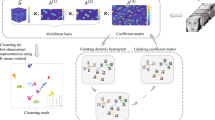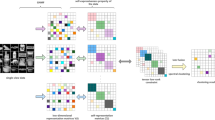Abstract
Non-negative Tucker decomposition (NTD) is a powerful tool for data representation to capture rich internal structure information from non-negative high-dimensional tensor data. Arguing that NTD methods often give global-like information, graph constraint has been introduced to capture the important local nonlinear structure of data. However, existing methods generally use fixed graphs and lack the ability to adaptively learn the optimal graph that best benefits the learning task at hand. In this paper, we propose an Adaptive Graph Regularized Non-negative Tucker Decomposition (AGRNTD) model. Not only is the new model able to capture the global multilinear structure of tensor data, but also it adaptively learns the optimal graph to capture local manifold information. An updating rule is designed to optimize the new model with the guarantee of local convergence. By mapping and visualizing the features, our method exhibits better feature extraction compared with other algorithms. The clustering results on five real-world datasets demonstrate the effectiveness and robustness of our method.






Similar content being viewed by others
Availability of data and materials
Data sharing not applicable to this article as no datasets were generated or analyzed during the current study.
References
Belkin M, Niyogi P (2003) Laplacian eigenmaps for dimensionality reduction and data representation. Neural Comput 15:1373–1396
Boyd SP, Vandenberghe L (2006) Convex optimization. IEEE Trans Autom Control 51:1859–1859
Cai D, He X, Han J et al (2011) Graph regularized nonnegative matrix factorization for data representation. IEEE Trans Pattern Anal Mach Intell 33(8):1548–60
Calvi GG, Moniri A, Mahfouz M, et al (2019) Tucker tensor layer in fully connected neural networks. ArXiv abs/1903.06133
Donoho D, Grimes C (2003) Hessian eigenmaps: locally linear embedding techniques for high-dimensional data. Proc Natl Acad Sci USA 100:5591–5596
Fang X, Han N, Wong W et al (2019) Flexible affinity matrix learning for unsupervised and semisupervised classification. IEEE Trans Neural Netw Learn Syst 30:1133–1149
Feng Y, Zhou G (2020) Orthogonal random projection for tensor completion. IET Comput Vis 14:233–240
Huang H, Ma Z, Zhang G (2022) Dimensionality reduction of tensors based on manifold-regularized tucker decomposition and its iterative solution. Int J Mach Learn Cybern 13:509–522
Jiang B, Ding C, Tang J et al (2019) Image representation and learning with graph-laplacian tucker tensor decomposition. IEEE Trans Cybern 49:1417–1426
Khan G, Hu J, Li T et al (2022) Multi-view data clustering via non-negative matrix factorization with manifold regularization. Int J Mach Learn Cybern 13:677–689
Kim Y, Choi S (2007) Nonnegative tucker decomposition. 2007 IEEE Conference on Computer Vision and Pattern Recognition 1–8
Kolda T, Bader B (2009) Tensor decompositions and applications. SIAM Rev 51:455–500
Kossaifi J, Lipton ZC, Khanna A, et al (2020) Tensor regression networks. ArXiv abs/1707.08308
Kuhn H (1955) The hungarian method for the assignment problem. Naval Research Logistics Quarterly 2:83–97
Lebedev V, Ganin Y, Rakhuba M, et al (2015) Speeding-up convolutional neural networks using fine-tuned cp-decomposition. CoRR abs/1412.6553
Lee D, Seung HS (2000) Algorithms for non-negative matrix factorization. In: NIPS
Li X, Ng M, Cong G et al (2017) Mr-ntd: manifold regularization nonnegative tucker decomposition for tensor data dimension reduction and representation. IEEE Trans Neural Netw Learn Syst 28:1787–1800
Martínez A, Kak A (2001) Pca versus lda. IEEE Trans Pattern Anal Mach Intell 23:228–233
Nie F, Wang X, Huang H (2014) Clustering and projected clustering with adaptive neighbors. Proceedings of the 20th ACM SIGKDD international conference on Knowledge discovery and data mining
Nie F, Wang X, Jordan MI, et al (2016) The constrained laplacian rank algorithm for graph-based clustering. In: AAAI
Oseledets I (2011) Tensor-train decomposition. SIAM. J Sci Comput 33:2295–2317
Paatero P (1999) The multilinear engine–a table-driven, least squares program for solving multilinear problems, including the n-way parallel factor analysis model. J Comput Graph Stat 8:854–888
Peng Y, Long Y, Qin F, et al (2019) Flexible non-negative matrix factorization with adaptively learned graph regularization. ICASSP 2019 - 2019 IEEE International Conference on Acoustics, Speech and Signal Processing (ICASSP) pp 3107–3111
Qiu Y, Zhou G, Wang Y, et al (2020) A generalized graph regularized non-negative tucker decomposition framework for tensor data representation. IEEE Transactions on Cybernetics
Roweis S, Saul L (2000) Nonlinear dimensionality reduction by locally linear embedding. Science 290(5500):2323–6
Shi J, Malik J (2000) Normalized cuts and image segmentation. IEEE Trans Pattern Anal Mach Intell 22:888–905
Tenenbaum J, de Silva V, Langford J (2000) A global geometric framework for nonlinear dimensionality reduction. Science 290(5500):2319–23
Wang C, He X, Bu J et al (2011) Image representation using laplacian regularized nonnegative tensor factorization. Pattern Recognit 44:2516–2526
Wu J, Xie X, Nie L, et al (2020) Unified graph and low-rank tensor learning for multi-view clustering. In: AAAI
Yi Y, Wang J, Zhou W et al (2019) Joint graph optimization and projection learning for dimensionality reduction. Pattern Recognit 92:258–273
Yin M, Gao J, Lin Z (2016) Laplacian regularized low-rank representation and its applications. IEEE Trans Pattern Anal Mach Intell 38:504–517
Yu J, Li C, Zhao Q, et al (2019) Tensor-ring nuclear norm minimization and application for visual: Data completion. ICASSP 2019 - 2019 IEEE International Conference on Acoustics, Speech and Signal Processing (ICASSP) pp 3142–3146
Yu Y, Zhou G, Zheng N, et al (2022) Graph regularized nonnegative tensor ring decomposition for multiway representation learning. IEEE Transactions on Cybernetics PP
Zhai H, Zhang H, Zhang L et al (2019) Laplacian-regularized low-rank subspace clustering for hyperspectral image band selection. IEEE Trans Geosci Remote Sens 57:1723–1740
Zhao Q, Zhou G, Xie S, et al (2016) Tensor ring decomposition. ArXiv abs/1606.05535
Zhao YY, Jiao CN, Wang ML et al (2021) Htrpca: hypergraph regularized tensor robust principal component analysis for sample clustering in tumor omics data. Interdisciplinary Sciences: Computational Life Sciences 14:22–33
Zhou G, Cichocki A, Zhao Q et al (2014) Nonnegative matrix and tensor factorizations: an algorithmic perspective. IEEE Signal Process Mag 31:54–65
Funding
This work is supported in part by the National Defense Basic Scientific Research Project (JCKY2020903B002), the Natural Science Foundation of China under Grant 62073087, Grant 62071132, and Grant 62203124, and in part by the Guangdong Natural Science Foundation under Grant 2023A1515012916.
Author information
Authors and Affiliations
Corresponding author
Ethics declarations
Competing interests
The authors declare that they have no known competing financial interests or personal relationships that could have appeared to influence the work reported in this paper.
Additional information
Publisher's Note
Springer Nature remains neutral with regard to jurisdictional claims in published maps and institutional affiliations.
Rights and permissions
Springer Nature or its licensor (e.g. a society or other partner) holds exclusive rights to this article under a publishing agreement with the author(s) or other rightsholder(s); author self-archiving of the accepted manuscript version of this article is solely governed by the terms of such publishing agreement and applicable law.
About this article
Cite this article
Chen, D., Zhou, G., Qiu, Y. et al. Adaptive graph regularized non-negative Tucker decomposition for multiway dimensionality reduction. Multimed Tools Appl 83, 9647–9668 (2024). https://doi.org/10.1007/s11042-023-15622-4
Received:
Revised:
Accepted:
Published:
Issue Date:
DOI: https://doi.org/10.1007/s11042-023-15622-4




